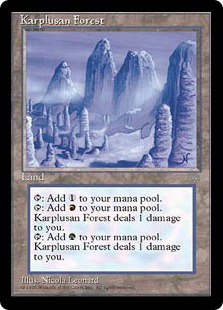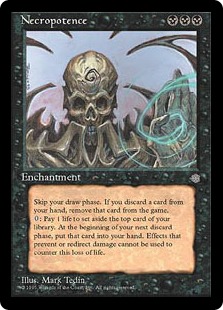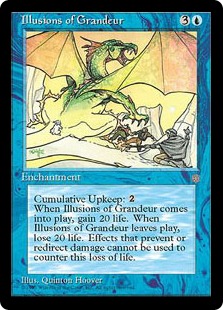Magic History: Let it Snow!

With Winter still in effect and the optimism of a new year looming, I figured that now would be the perfect time to take a look at Magic the Gathering's first stand-alone set, Ice Age! Nowadays we're used to getting a new standalone set multiple times per year, but for the first few years in Magic that wasn't the case. There were some early sets that were enormous in size like Legends, but other than the erroneous Arabian Nights Mountain, basic lands and sealed-deck staples weren't an auto-include part of sets.

Released in June of 1995 Ice Age was the sixth expansion set for the game, and eleventh set released overall (counting core editions). The 383 cards found in Ice Age were sold in fifteen-card booster packs and sixty-card "Starter Decks," as was usual at the time. For those of you who don't remember, Starter Decks were the original "entry level" type of sealed offering, These decks had sixty cards and included enough basic lands to make a rudimentary deck. Up to this point, only the core sets of Alpha, Beta, Unlimited, Revised, and Fourth Edition had Starter Decks associated with them. Also, basic land cards had been removed from core set booster packs for a while, so these Starter Decks were the only place to get the new Ice Age art lands.

The set brought a lot of powerful new abilities, themes, and concepts into the game. The events in this set took place in the plane of Dominaria during an era where it was frozen solid in an ice age, so the cards and abilities revolved around the frigid experiences of an arctic adventure. Basic lands came in their regular flavors, but some were printed as "Snow-Covered" versions (later changed simply to "Snow lands" with "Snow" being a supertype). Much of the artwork depicted this blanket of snow, even on cards that weren't officially "Snow lands."

There certainly was no shortage of flavorful and winter-themed cards in Ice Age; classic pieces such as Ice Flow, Glacial Chasm, and Goblin Snowman are very evocative of this sub-zero theme. There was much more to love about the set than just the lore and flavor though. There were also some extremely powerful cards in the set.



Since Ice Age was designed to be a stand-alone set it needed to have the proper balance and selection of cards. By 1995 Wizards of the Coast understood that limited play was as important as constructed, so they made sure to fill Ice Age with some reprints, some functional reprints, and some "fixed versions" of older card types. Let's take a look at some of these!
Color Fixing
Before Ice Age, players had access to the usual basic lands, and for multicolored decks there were the original ten dual lands and a few rainbow lands like City of Brass. Wizards had recognized that the problem with the original dual lands was that they were so good they created no incentive to use basic lands. "Counting as both land types" might have made your Tundra vulnerable to Flashfires and Tsunami, but that was a small price to pay for perfect mana. Wizards created two types of color fixing lands for Ice Age, the depletion lands and the pain lands.
Depletion Lands
Like both kinds of dual lands in Ice Age, the depletion lands were printed only as allied color pairs. These lands were not very good unfortunately, even though they inspired equally bad lands in Tempest and Champions of Kamigawa. Eventually the development team learned that coming into play tapped (like Shock Lands, Scry lands, or Gain lands) was much better, and that has been the status quo ever since.
Pain Lands




Pain lands were the second-best type of dual land design until the Shock Lands were introduced in Ravnica block. By modern standards these lands are somewhat weak as they cannot be used in conjunction with Fetch Lands, but it's important to remember that the original Onslaught era Fetch Lands were a long ways away at this point. The fact that these lands can be used the turn that they are played is huge. It's true that the damage from these cards does add up, but good Magic players have always known that life points don't matter until you're dead.
With the two new types of dual lands available to players it became possible to easily play multicolored decks in constructed and limited formats. The same year that Ice Age was released also saw the initial creation of two Magic formats: Type I (Vintage) and Type II (Standard). Since the newly created Standard format would only allow the newest cards to be used it was imperative that players had access to a replacement for the original dual lands (which had been removed from the core set after Revised Edition).
Reprints
In the modern era of Magic: the Gathering, we players sometimes take reprints for granted. The truth is that even though players still clamor for certain cards to be reprinted the player base is actually fairly lucky that we have access to reprints. In the early years of the game cards weren't being reprinted whatsoever and as such many cards were hard to come by. The trend for reprinting cards started when Ice Age (and the preceding release Fourth Edition) contained reprints.
Certain cards in Magic had become staples of the game and they were important enough that Ice Age couldn't function as a stand-along set without them. Quite a few staple cards were either directly reprinted or had nearly identical cards printed in Ice Age. Dark Ritual was considered an important black card, so it got a reprint. The cycle of Circles of Protection and Healing Salve got reprinted for white. Giant Growth and Fyndhorn Elves went to green. Red ended up with Incinerate instead of Lightning Bolt, possibly because it was now considered too good for Standard. Blue had it's iconic spell added to the ranks with a new printing of Counterspell.
Looking back at Ice Age I feel like the designers were trying to bring the original "Boon Cycle" back into the game. The original boons were Dark Ritual, Healing Salve, Giant Growth, Lightning Bolt, and Ancestral Recall. Three of the original boons ended up getting reprinted in the set, and two of them got fixed versions printed. Red had the aforementioned fixed version of Lightning Bolt, and blue got a fixed version of Ancestral Recall:

Oh Brainstorm... If only your creator knew the fantastic things you would do over the years!
Brainstorm was the first attempt at fixing Ancestral Recall, and like nearly every other attempted fix, this one ended up being too good. It is true that it took a while before Brainstorm was recognized for its true power, but drawing three cards was always very good even with the drawback of having to put two back. Once the Fetch Lands were printed and it became easy to shuffle away the unwanted cards, Brainstorm became the powerhouse that it is today. The card is now legal only in Legacy and Vintage, but it's restricted in Vintage and many people have said it should be banned from Legacy. While I don't support the calls for a Legacy Brainstorm ban, I understand the argument.
Cantrips (Or Slow-Trips...)
Oddly enough, in contemporary Legacy and Vintage, Brainstorm is often lumped in with a very similar card called Ponder. While Ponder wasn't first printed until much later in Lorwyn, Ice Age contained a oft forgotten cantrip that is eerily similar...


Portent is almost identical to Ponder except it can target any player's library and the "cantrip" effect doesn't happen until the next turn's upkeep. Ice Age was the first set to have cantrips, cards with small effects that replace themselves with a single drawn card. All the cantrips from the early years of Magic delayed the cantrip effect, and it wasn't until much later that this policy was changed. The "Slow-Trip" version of the cantrip effect has become associated with Ice Age ever since, and thus this templating was used in the Ice Age throwback expansion Coldsnap. You can see an example of this when comparing Urza's Bauble and Mishra's Bauble.


Notable Cards
The list of noteworthy cards from Ice Age is very long, and even to this day many of the cards have withstood the test of time. One of the faces for the set were the twin "Jester's artifacts," Jester's Cap and Jester's Mask.


Both Jester's Cap and Mask were sought-after cards, although good players quickly learned that the Mask was actually pretty terrible. Still, they were really sweet cards for their time period. Jester's Mask does something very unusual, so it was hard to judge at first. One of the most popular sources of Magic content in the Ice Age era was Inquest Magazine, and that publication was notoriously bad at card evaluation. The writers at Inquest seemed to think that Jester's Mask was as good as Jester's Cap for some unknown and comical reason, and that must have driven its price up!
Jester's Cap is still fringe-playable to this day. In the Vintage format Mishra's Workshop decks can easily cast Jester's Cap, and it gives the all-artifact deck a way to deal with cards it otherwise could not.
The effect that Jester's Cap has is tough to measure as the card provides absolutely no card advantage as it doesn't effect the board or an opponent's hand. Cap removes threats preemptively, but it can't ever save you when you're behind as it only affects a zone that's not relevant to the board position. Even though Jester's Cap is a relic of Magic's past, it has a legacy that lives on to today. Cards like Lobotomy, Cranial Extraction, Slaughter Games, and even to some extent Surgical Extraction all owe their existence to Jester's Cap. Each of those "exiling" effects is reminiscent of Jester's Cap, and they can be seen as descendants of the classic Ice Age artifact.



Another one of the most notable cards from Ice Age also shaped an entire summer of tournament Magic. In the summer of 1996 everyone seemed to be in love with the Skull.

Greed predated Necropotence as the first black enchantment that turned life points into a resource that could be traded for cards, but good old Necro was much more efficient. For only three black mana (perfectly priced to be cast with Dark Ritual!) you could turn any amount of life you were willing to pay into fresh cards off the top of your deck. This massive card advantage was tough for other decks to keep up with, and once a good shell for Necropotence was found it became nearly unstoppable.

The Necro decks also featured a few other classic Ice Age cards. Demonic Consultation was a fixed version of Demonic Tutor. but it ended up being even more powerful. As a matter of fact Demonic Consultation is only legal in Vintage these days, and it's on the restricted list.

Necro decks also played a singleton copy of a zero-cost life-gaining artifact called Zuran Orb. Gaining life for sacrificing lands was great in a Necro shell, but it was also used in plenty of other things. With Balance, a card that was still legal in Standard at the time, it was an Armageddon. In conjunction with Land Tax (and later Scroll Rack) Zuran Orb turned into an important cog in a card advantage engine. Although Zuran Orb looks tame by modern comparison, the card was so powerful that it was eventually restricted for a time.

Stormbind is another classic Ice Age card. Repeatable direct damage is a powerful ability, and this was one of the earliest examples of that. The most famous use of the green and red enchantment was probably in Hall-of-famer Olle Rade's Pro Tour winning Ice Age block deck.


Olle's deck also featured Pyroclasm, a card that is still played to some extent these days. A two-mana creature sweeper is quite good, and this sorcery was a staple in the G/R Tron decks of past Modern formats.

Pox may be the sickest card in the entire set. The three-mana black sorcery has a very powerful effect, and it's had entire decks built around it. Most "Pox" decks in the modern era play Smallpox instead, but "Big Pox" is still a deadly card to inflict upon opponents.

The last card I'll feature today was relegated to bulk bins for most of its existence. Illusions of Grandeur is just plain bad, and as such nobody wanted to play it. The only reason that this card ever saw tournament play is that a card was eventually printed that allowed people to Donate the enchantment to their unwitting opponents!


Once Donate was printed, Illusions of Grandeur became paired with it in a Necropotence-fueled combo deck called "Trix." It tore through the extended format in which it was legal. Eventually the dominance of Trix caused Dark Ritual and Necropotence to be banned, and the deck soon faded into obscurity.
Ice Age: Final Thoughts
Ice Age was an amazing set and it represents an era of Magic that I sorely miss. I know they say "you can't go back," but if I could, I'd love to revisit those years. The sets released during my youth surely were not perfect, and in some ways they are crude compared to the slick productions that Wizards of the Coast puts forth today. Still, there's something magical about the Ice Age era and I'm glad that I can help showcase that to those who did not experience it firsthand. There were so many awesome cards from Ice Age that I couldn't fit all of them into a single article. I highly suggest that people take a peek at Gatherer and look at the entire set because there's even more to discover!

Soul Burn, by Rob Alexander
I'll end this nostalgic trip through memory lane with a pair of questions. If you experienced Ice Age yourself, what about the set do you remember most fondly? And for those of you who hadn't started playing (or perhaps weren't born yet) when Ice Age was released how does the set look to you? I'd love to hear your answers in the comments, or you can hit me up on Twitter @Islandswamp. Thanks for reading!
















